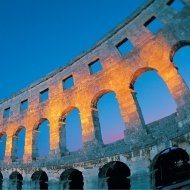Rent a car Pula Croatia
Car rental at Pula Croatia
 Pula is the biggest city in Istria, Croatia. The city with it's accompanying villages (Barban, Fažana, Vodnjan, Svetvinčenat, Ližnjan and Marčana) counts around 100 000 residents. It is well-known for its mild meditteranean climate with average summer temperature of 26,4 °C, clean sea and beautiuful scenery. Pula is an administrative center of Istria since the time of the Roman empire. Pula is an administrative center of Istria since the time of the Roman empire. Pula has a long tradition of wine production, fishing, tourism and ship manufacturing. The most famous monuments origin from the Roman time. The amphitheatre, commonly called Arena Pula, was built during the regency of the Roman emperor August, and during the regency of the Flavians was extended to it's present form. Because of its size and soundness it is as valuable as the Colluseum in the city of Rome. The Arch of the Sergeii, aslo called "The Golden Gate", is an Roman triumphal arch dedicated to three brothers of the Sergeii family. Hercule's doors are the oldest monument of the Roman architecture in Pula. The Temple of Augustus is located on the Pula's main square named Forum and presents the most sound Roman temple in Pula. Intact nature of Pula's surrounding and clean sea make Pula a popular summer destination. In the vicinty of the city, only half an hour of a pleasant boating from Fažana, is the "Brijuni" national park. It consists of 14 islands and islets. Few villas and hotels provide a luxury accomodation. Playing golf on beautiful golf courses and walking through the Safari park are ideal way of relaxing near the turquoise sea and breathtaking scenery.
Pula is the biggest city in Istria, Croatia. The city with it's accompanying villages (Barban, Fažana, Vodnjan, Svetvinčenat, Ližnjan and Marčana) counts around 100 000 residents. It is well-known for its mild meditteranean climate with average summer temperature of 26,4 °C, clean sea and beautiuful scenery. Pula is an administrative center of Istria since the time of the Roman empire. Pula is an administrative center of Istria since the time of the Roman empire. Pula has a long tradition of wine production, fishing, tourism and ship manufacturing. The most famous monuments origin from the Roman time. The amphitheatre, commonly called Arena Pula, was built during the regency of the Roman emperor August, and during the regency of the Flavians was extended to it's present form. Because of its size and soundness it is as valuable as the Colluseum in the city of Rome. The Arch of the Sergeii, aslo called "The Golden Gate", is an Roman triumphal arch dedicated to three brothers of the Sergeii family. Hercule's doors are the oldest monument of the Roman architecture in Pula. The Temple of Augustus is located on the Pula's main square named Forum and presents the most sound Roman temple in Pula. Intact nature of Pula's surrounding and clean sea make Pula a popular summer destination. In the vicinty of the city, only half an hour of a pleasant boating from Fažana, is the "Brijuni" national park. It consists of 14 islands and islets. Few villas and hotels provide a luxury accomodation. Playing golf on beautiful golf courses and walking through the Safari park are ideal way of relaxing near the turquoise sea and breathtaking scenery.
Login
Register
Car rental includes
- CDW (Collision Damage Waiver)
- TP (Theft Protection)
- PAI (Personal Accident Insurance)
- Aerodrome fees / taxes
- VAT 25%
- Unlimited kilometers
- Roadside Assistance 24/7
Rent a Car Locations









